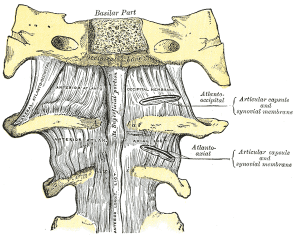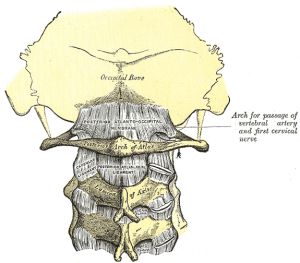Atlanto-occipital joint: Difference between revisions
Rachael Lowe (talk | contribs) No edit summary |
Kim Jackson (talk | contribs) m (Text replacement - "Category:Anatomy - Cervical Spine" to "") |
||
| (12 intermediate revisions by 5 users not shown) | |||
| Line 1: | Line 1: | ||
<div class="editorbox"> | <div class="editorbox"> | ||
'''Original Editor '''- [[User:Rachael Lowe|Rachael Lowe]] | '''Original Editor''' - [[User:Rachael Lowe|Rachael Lowe]] | ||
'''Lead Editors''' | '''Lead Editors''' - [[User:Evan Thomas|Evan Thomas]] | ||
</div> | </div> | ||
== Description == | == Description == | ||
[[Image:Atlanto-occipital joint anterior.png|thumb|right|Atlanto-occipital joint (anterior)]][[Image:Atlanto-occipital joint posterior.png|thumb|right|Atlanto-occipital joint (posterior)]]The atlanto-occipital articulations function as bilaterally symmetrical ellipsoid synovial joints between C0 and C1. | [[Image:Atlanto-occipital joint anterior.png|thumb|right|Atlanto-occipital joint (anterior)]][[Image:Atlanto-occipital joint posterior.png|thumb|right|Atlanto-occipital joint (posterior)]]The atlanto-occipital articulations function as bilaterally symmetrical ellipsoid synovial joints between C0 and C1. | ||
== Articulating Surfaces == | == Articulating Surfaces == | ||
| Line 12: | Line 12: | ||
Occipital condyles and a superior articular facets of the atlas. | Occipital condyles and a superior articular facets of the atlas. | ||
== Ligaments & Joint Capsule | == Ligaments & Joint Capsule == | ||
The capsule is rather roomy and relaxed and the joint possesses no individual accessory ligaments. Stability is provided by:<br> | The capsule is rather roomy and relaxed and the joint possesses no individual accessory ligaments. Stability is provided by:<br> | ||
| Line 20: | Line 20: | ||
*[[Anterior atlanto-occipital ligament]] | *[[Anterior atlanto-occipital ligament]] | ||
== | == Degrees of Freedom == | ||
= | Two degrees of freedom are available at this joint:<ref name="Ortho Div CPA">Orthopaedic Division of the Canadian Physiotherapy Association. Biomechanics of the Atlanto-Occipital Joint. Clinical Technique Manual: Level II Upper Quadrant (2010). Pg 28-30.</ref> | ||
#Flexion/extension | |||
#Lateral flexion/conjunct rotation | |||
== Osteokinematics<ref name="Ortho Div CPA" /> == | |||
*Flexion/extension | |||
**Cardinal (pure) swing | |||
**Total ROM: 30° (10° flexion, 20° extension) | |||
**Axis: Transverse axis through external auditory meatus | |||
*Lateral flexion | |||
**Arcuate (impure) swing with coronal conjunct rotation (e.g. right lateral flexion occurs with conjunct left rotation) | |||
**Total ROM: 15° (8-10° in each direction) | |||
**Axis: Oblique sagittal axis through the nose (approximately) | |||
**Associated with AA joint rotation | |||
*Rotation (conjunct) | |||
**Occurs with lateral flexion due to the slanted articular surfaces, anteromedial orientation of the articular facets, and the alar ligaments | |||
**Total ROM: 5-7° in each direction | |||
**Axis: Vertical axis anterior to the foramen magnum | |||
== Arthrokinemtics<ref name="Ortho Div CPA" /> == | |||
*Flexion | |||
**Forward tilt/nod of the head | |||
**Posterior glide of the convex occipital condyles on the concave atlantal facets | |||
**Atlas moves anterior and cranially | |||
**Dens follows atlas and approaches the clivus | |||
**Occiput and the posterior atlantal arch separate | |||
*Extension | |||
**Backward tilt of the head | |||
**Anterior glide of the convex occipital condyles on the concave atlantal facets | |||
*Lateral flexion (left lateral flexion example provided below) | |||
**Left lateral tilt of the head causes a contralateral glide of the occiput | |||
**Conjunct right rotation occurs due to the anteriormedial axis of the joint surfaces | |||
**Right glide of the occipital condyles causes relative anterior glide of the left condyle on and a relative posterior glide of the right condyle | |||
**Occipital portion of the right alar ligament tightens, with the left being slackened | |||
**Tension in the right alar ligament pulls on the dens and causes a left rotation of the axis | |||
**Spinous process of the axis moves to the right creating a relative right rotation of the AA joint | |||
== Muscle Action at this Joint == | |||
'''Flexion''' is produced mainly by the action of the rectus capitis anterior. Limited by tectoral membrane. | '''Flexion''' is produced mainly by the action of the rectus capitis anterior. Limited by tectoral membrane. | ||
| Line 33: | Line 72: | ||
'''Extension''' by the rectus capitis posterior major and minor, assisted by the obliqus capitis superior, the semispinalis capitis, splenius capitis, sternocleidomastoid, and upper fibers of the trapezius. | '''Extension''' by the rectus capitis posterior major and minor, assisted by the obliqus capitis superior, the semispinalis capitis, splenius capitis, sternocleidomastoid, and upper fibers of the trapezius. | ||
The rectus capitis lateralis are concerned in the '''lateral flexion''', assisted by the trapezius, splenius capitis, semispinalis capitis, and the sternocleidomastoid of the same side, all acting together. | The rectus capitis lateralis are concerned in the '''lateral flexion''', assisted by the trapezius, splenius capitis, semispinalis capitis, and the sternocleidomastoid of the same side, all acting together. | ||
== Pathology | == Pathology == | ||
*[[Jefferson fracture|Jefferson fracture]] | *[[Jefferson fracture|Jefferson fracture]] | ||
* | *Atlanto-occiptal dislocation | ||
== Resources == | == Resources == | ||
*[https://www.youtube.com/watch?v=Ocp5XGW3z4k Flexion/extention motion at the AO joint (YouTube)] | |||
== References == | == References == | ||
<references /> | <references /> | ||
[[Category: | [[Category:Cervical Spine - Anatomy]] | ||
[[Category:Joints]] | |||
[[Category:Cervical Spine - Joints]] | |||
[[Category:Cervical Spine]] | |||
Latest revision as of 13:40, 23 August 2019
Original Editor - Rachael Lowe
Lead Editors - Evan Thomas
Description[edit | edit source]
The atlanto-occipital articulations function as bilaterally symmetrical ellipsoid synovial joints between C0 and C1.
Articulating Surfaces[edit | edit source]
Occipital condyles and a superior articular facets of the atlas.
Ligaments & Joint Capsule[edit | edit source]
The capsule is rather roomy and relaxed and the joint possesses no individual accessory ligaments. Stability is provided by:
- Two articular capsules
- Posterior atlanto-occipital ligament
- Anterior atlanto-occipital ligament
Degrees of Freedom[edit | edit source]
Two degrees of freedom are available at this joint:[1]
- Flexion/extension
- Lateral flexion/conjunct rotation
Osteokinematics[1][edit | edit source]
- Flexion/extension
- Cardinal (pure) swing
- Total ROM: 30° (10° flexion, 20° extension)
- Axis: Transverse axis through external auditory meatus
- Lateral flexion
- Arcuate (impure) swing with coronal conjunct rotation (e.g. right lateral flexion occurs with conjunct left rotation)
- Total ROM: 15° (8-10° in each direction)
- Axis: Oblique sagittal axis through the nose (approximately)
- Associated with AA joint rotation
- Rotation (conjunct)
- Occurs with lateral flexion due to the slanted articular surfaces, anteromedial orientation of the articular facets, and the alar ligaments
- Total ROM: 5-7° in each direction
- Axis: Vertical axis anterior to the foramen magnum
Arthrokinemtics[1][edit | edit source]
- Flexion
- Forward tilt/nod of the head
- Posterior glide of the convex occipital condyles on the concave atlantal facets
- Atlas moves anterior and cranially
- Dens follows atlas and approaches the clivus
- Occiput and the posterior atlantal arch separate
- Extension
- Backward tilt of the head
- Anterior glide of the convex occipital condyles on the concave atlantal facets
- Lateral flexion (left lateral flexion example provided below)
- Left lateral tilt of the head causes a contralateral glide of the occiput
- Conjunct right rotation occurs due to the anteriormedial axis of the joint surfaces
- Right glide of the occipital condyles causes relative anterior glide of the left condyle on and a relative posterior glide of the right condyle
- Occipital portion of the right alar ligament tightens, with the left being slackened
- Tension in the right alar ligament pulls on the dens and causes a left rotation of the axis
- Spinous process of the axis moves to the right creating a relative right rotation of the AA joint
Muscle Action at this Joint[edit | edit source]
Flexion is produced mainly by the action of the rectus capitis anterior. Limited by tectoral membrane.
Extension by the rectus capitis posterior major and minor, assisted by the obliqus capitis superior, the semispinalis capitis, splenius capitis, sternocleidomastoid, and upper fibers of the trapezius.
The rectus capitis lateralis are concerned in the lateral flexion, assisted by the trapezius, splenius capitis, semispinalis capitis, and the sternocleidomastoid of the same side, all acting together.
Pathology[edit | edit source]
- Jefferson fracture
- Atlanto-occiptal dislocation








